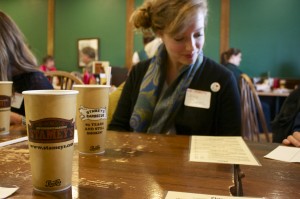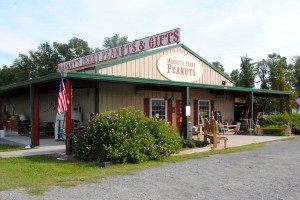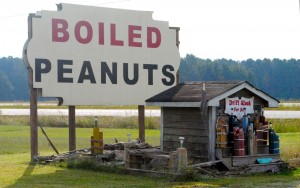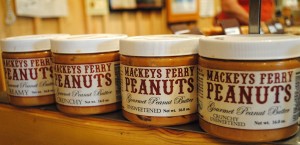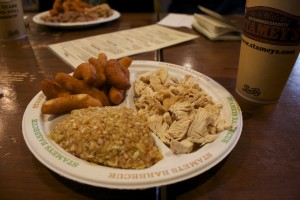
As part of our experience practicing writing as inquiry, we have learned about the importance of ethnographic research and of thick, detailed description of places and experiences. For this North Carolina Barbecue Project, students went on two field trips: one to the Lexington Barbecue Festival in Lexington, NC on October 27, 2012 and one to Stamey’s Barbecue in Greensboro, NC on November 15. While visiting both the Lexington BBQ Festival and Stamey’s, some students distributed surveys, others interviewed people, and a few conducted ethnographic research.
Below, you will find an ethnographic account of one student’s experience at the Lexington BBQ Festival, and another student’s account at Stamey’s Barbecue in essay format. You will also find analyses of several surveys distributed at the festival, in the restaurant, and online. The last thing included in this section is an interview with a Lexington BBQ Festival attendee.
1) Challenging Cultural Expectations at the Lexington Barbecue Festival
By Mia Brady
When driving through the tiny town of Lexington, personal driveways turned parking lots were found on every corner, with residents directing traffic. It was clear to me that Lexington was experiencing a day during which their little North Carolina town was filled with more people than usual. After paying $5 for parking and walking up a hilly, narrow road, we found ourselves in the middle of the Lexington Barbecue Festival. I couldn’t help but feel I was in the midst of a bustling flee market. Rows and rows of little tents were set up, selling everything from BBQ sauce (appropriately) to little knickknacks, like wood picture frames and cloth purses. I found myself confused initially; so where was the barbecue? I wanted more than just sauce! From my first few moments there, I knew that this festival would be different than I expected.
Before coming to the festival, I expected the focus to be on North Carolina BBQ, with lots of different recipes of authentic barbecue available. But as we wandered around, taking in the energetic atmosphere, we noticed lots of fried food tents and commercialized foods. Fried Oreos, Snickers, Twix. Any candy you can name, it was there- fried. Not to mention, fried chicken and onions. As a New Jersey native, I couldn’t help but be reminded of the boardwalk at the Jersey Shore. This was authentic North Carolina food? We finalized stumbled upon a tent for roasted corn on the cob, and were reassured to have an option that wasn’t fried. Of course, you could have your corn dipped in a vat of butter (which I opted out from) but hey, it was still a vegetable right? I have to admit, this corn was delicious. Perfectly roasted and tasty. As we chomped on our corn, we wandered through the eclectic crowds. There were groups of teenagers, families with young children, middle-aged groups of women, elderly couples holding hands, 20 somethings. There was no question that the festival drew in all different types of people.
We took some time to walk along the row of tents. Of course we came across tents for bows, flags, jewelry, clothing, ornaments, etc. We began to meander between the tents, finding the places to try different barbecue sauces dispersed within the tents housing t-shirts and costume jewelry. We skipped on the commercial tents, and made sure that we tried every barbecue that we could find. We waited patiently at each of the sauce tents, with the scent of barbecue wafting as we waited. From Bubba’s Finger Lickin, Throat Ticklin sauce to Nephew’s BBQ Pumpkin flavored sauce to Knot a Yankee BBQ sauce (which was the only sauce that served theirs’ with some actual meat!), we got our fair share of tastings, from sweet to spicy. Tasting the different sauces was a nice reminder of the validity of this barbecue festival.
After spending some time tasting, we walked by a parking lot full of show cars, passed a stage with live country music, and found our way to a large map. We were curious to find the actual barbecue tents serving sandwiches and platters, and were shocked to see that there were only three large tents in the whole festival that were serving fully barbecue meals. We asked a woman who was handing out handheld maps, and she filled us in; the three tents were served by attendees and volunteers from barbecue restaurants in the area, like Stamey’s in Greensboro and Smokey Joe’s in Lexington. We took some handheld maps and were on our way, navigating through the crowds walking in aisles between the tents, past men holding “Trust Jesus” signs and shouting religious praises. We peaked in at each tent making up the long rows, watching people have caricatures drawn, tasting different chocolates and peanuts, and looking at Christmas ornaments and glass figurines. Of course we made sure to stop at all the food, not wanting to miss out on Carolina Kettle Corn, Virginia Peanut Company or the many samples of maple butter fudge, peanut butter fudge or dark chocolate fudge.
It took us about a half hour to get to the other side of the festival, between the crowds and our interest in the food tents. Once we finally reached one of the massive barbecue tents, we realized it was a good thing that we had stopped and snacked, because the lines were quite long. We found ourselves waiting amongst hungry barbecue fiends, for about 20 minutes with very little progress. I overheard a passerby say, “This is the only barbecue tent here!” While her observation was in fact incorrect, I could see where she was coming from. To the right of the tent was a seating area with about 10 long tables filled completely with groups of families and friends chatting and eating their barbecue; sandwiches, curly fries, hotdogs and barbecue trays on foil. I was surprised to see that these items were the only ones on the menu, but realized as I got closer and closer to ordering, that it simply made the process easier for the servers. As I peaked behind the servers into the inside the large barbecue tent, the hectic atmosphere was palpable. And it was no question why the atmosphere was so frantic; these servers had to make sure that each of the tens of thousands of hungry festival goers received their barbecue, and were content with their barbecue.
When we were finally close enough, all four of us ordered $5 barbecue sandwiches and received our food almost immediately. Opening the foil, I had very high expectations. As I bit into my tender, vinegar-based sandwich, I involuntarily “mmmed” at the delicious taste. So it was worth the wait. I opened the top of thee sandwich, and noticed that the meat was cut in very small chunks, and toped with tasty vinegar coleslaw. My classmates and I unanimously agreed; this was good. I looked around me at the hundreds of people, enjoying their barbecue. I couldn’t help but realize that despite the somewhat cheezy atmosphere, and the few tents serving actual barbecue meals, the Lexington Barbecue Festival added something to the culture of North Carolina Barbecue. The draw of the festival was unquestionable; barbecue lovers united at this event that is bound to continue for years to come.
2) Local Experience at the Lexington Barbecue Festival
By Brittany Wheatley
The only city festival I’ve ever been a part of is my hometown’s 4th of July celebration. The sidewalks are lined with crafts and decorations that try to link the passerby with the local businesses and a feeling of community.
When I was preparing myself to see the 29th Annual Lexington Barbecue Festival, an event that I had often heard of in the course of the two month count down, I did not picture Laurel, Delaware. I was expecting a fairground with plenty of parking, not Lexington’s Main Street shutdown from 5th Avenue to 4th Street and a $5 fee for all day parking in the backyard of longtime local, Kep Keply.
I arrived at 4:30pm, ready to spend the last 90 minutes of 2012’s festival with eyes wide open and my voice recorder close at hand so as not to spare a second when experiencing historic Uptown Lexington. Kep Keply was my first interview, and from him I learned that waiting for the end of the festival might have been a good choice if I wanted to see everything the vendors had to offer. “Two hours ago is was so crowded, you wouldn’t have been able to find parking, see the festival, or walk the trail.”
Keply has lived in Lexington since he was a young man, although he hasn’t been to the barbecue festival in years. With each passing year, the need for parking has increased and many community member like Keply charge a small all day fee to visitors so they can park in backyards. And it was here that I learned a community approach to the local festival I had never considered.
When I asked how he felt about the local event, I expected Keply and his neighbors to be rejoicing at the chance to share their community with others. The festival brings people from as far away as Germany and Australia to buy from a huge selection of food and craft vendors. Instead I learned that the event can be frustrating for locals and businesses. There isn’t enough parking, there aren’t enough people to organize a new system of parking, and almost all the businesses in the area of the festival have to close for the festival.
Some businesses, like the Purple Pig Emporium, stayed open; but it’s hard to compete for business with the festival affecting transportation. And there is a question of how cost effective is is for those towns to open on festival days. For the Purple Pig Emporium, the festival was their opportunity as a new store location to get their name out to the public. An art and collection gallery in which artists rent out a space and design to attract customers, the Purple Pig Emporium targets customers looking for something different. The owners were first attracted to Lexington because they saw the town as a growing shopping location. By just a glance in their store, they seemed to have plenty of customers despite the craft and attraction competition outside.
Vendors for the festival are approved by the festival director Stephanie Naser, who is also the daughter of the original Lexington Barbecue Festival, Stephanie Saintsing. Vendors submit a petition to be able to participate the festival. Some of the attractions that stuck out were a Statue Mime, Carnival Tent with an Elephant and Pigs sandcastle and the Farm Animal Race.
White painted face matches the tux and top hat of the Statue Mime who asks for tips to support local art; for a dollar or more, he plays a tune on black guitar an avenue before the Farm Animal Race. Pig and ducks with NASCAR related names (like Number Fourteen, Squealing Tony Stewart) attracted the kids and parents not busy with the kiddie rides or “The Tales of Barnacle Bill: Pirates, Poets and Pretty Maid All in a Row”.
The main attraction I expected was for the barbecue itself. I was looking forward to a competition between barbecue vendors, with a large selection of barbecue styles to choose from. What I found was multiple Lexington barbecue restaurants working together to create fifteen to sixteen thousand pounds of one recipe. Although it didn’t meet my expectation, the people and barbecue I was introduced to were phenomenal. I even saved enough room to try a North Carolina hand lump blue crab cake, a much creamer recipe than I have access to in my hometown.
Seeing the closing down of the 29th Annual Lexington Barbecue Festival allowed me to see the evolution of a local festival from massively populated to the barebones of a closed down town. The stark difference encourages me to want to see the beginning of the festival until it’s peak in 2013.
3) Writing in a Notebook at Stamey’s Barbecue
By Will Stiefel
Walking in to Stamey’s, you encounter a small waiting area with a counter in front of you. It is 1:00 PM on a Thursday. The counter runs around an entire side of the dining room, surrounding the kitchen, registers, and server area. Mostly individuals are seated at the bar and, when possible, there is a seat separating each customer. The customers at the bar are all older gentleman, appearing over the age of 40. Each has a coffee and one man is drinking a milkshake. Not everyone is eating at the bar. Those who eat, have a small sandwich or a small plated portion of chicken. While the men at the bar sit, drink, and eat quietly, the female servers buzz around cleaning and taking orders. Each server has her own section and keeps a very pleasant demeanor.
The main dining area is in front of the bar. There is a row of square tables running parallel to the bar, equally as long, with enough room to pass between the two sections comfortably. Each table sits four and none are full. The average table has two people sitting and eating, everyone who sits at a table orders food. One young soldier in uniform sits with his friends at a table near the back of the room.
A row of booths runs parallel to the tables along the wall opposite of the bar. More people are drawn to the booth tables than the middle tables. The wall along the booth is filled with old pictures from the early days of Stamey’s. These depict men fueling the barbeque pits or customers filling the restaurant. The pictures give the inside atmosphere a more traditional sense of barbeque.
The tables are in high demand at the peak of rush and the waitresses turn them over as quickly as possible. However, everyone seems to be taking his or her time eating, talking, and relaxing. While the restaurant is still crowded, our presence is not obvious. However, the rush comes and goes fairly quickly and, at around 2:20 PM, the restaurant is about a quarter as crowded. Now, as we are ushered to our seats in the corner of the restaurant, the majority of patrons are much older. Other than one man sitting by himself, everyone inside is seated at a booth table. There are three older couples, two middle-aged ones, and two mothers with children. The bar is now completely empty when it was full only fifteen minutes prior to us sitting. Post lunchtime rush must be a more flexible, quiet time for couples and families to eat at the restaurant.
The food is brought out very quickly, on different sized paper plates depending on what is ordered. Sides come in separate dishes. I order the sliced pork sandwich, which comes with coleslaw on top of the pork. I add the vinegar based barbeque sauce they provide because just the pork and coleslaw is a little too dry for my taste. The sandwich is delicious, the pork extremely tender. I also have a side of hush puppies that are equally well done. Crispy on the outside, warm and moist on the inside, just how they should be. Everyone else enjoys their food and the waitress is prompt, patient, and pleasant when dealing with is. Finally, when we are closing out our bill, the restaurant is relatively empty, with only three or four tables being used. The smell of pork wafts throughout the inside and even finds its way outside surrounding the restaurant. However, we learn that the pork is not cooked here. Rather, all of the pork is smoked at their High Point Road location.

Lexington BBQ Survey Results
By Julia Realmuto
After sorting through several surveys from the Lexington BBQ Festival we were able to garner a lot of information about how people view North Carolina BBQ and its importance. Overall, we had 93 people participating in our survey. Of that 93, 63 thought they knew the difference between Eastern and Western North Carolina BBQ and 30 were able to admit they did not know the difference. Furthermore, 77 people were unbiased and said they would eat the other type of BBQ even if it was not their preference although there were 9 people who were die-hard BBQ lovers and would not eat the other type. Finally, 52 participants thought that BBQ was ‘very important’ to North Carolina culture, which was the overriding answer. Most people thought that BBQ had an important impact, which illustrates how ingrained BBQ is to the people of North Carolina. Interestingly, only 2 people out of the 93 thought that BBQ was not important at all to the culture.
Stamey’s BBQ Survey Results
By Phoebe Hyde
After reviewing the survey data collected at Stamey’s Restaurant in Greensboro, NC, we were able to gain a sense for how people view North Carolina BBQ and the overall importance of BBQ. Overall, we surveyed 34 customers at Stamey’s. Of those 34 customers, 18 of them could articulate the difference between Eastern and Western North Carolina BBQ. Meanwhile, 25 of the customers surveyed stated that they were unbiased towards the two types of BBQ, regardless of their preference, and would eat both types. None of the customers surveyed were die-hard enough BBQ fans that they would refuse to eat either type of BBQ. Further, 17 of the 34 people surveyed believe that BBQ is “important” to North Carolina culture, while 11 out of the 34 people surveyed feel that BBQ is “very important” to North Carolina culture. Only one person believes that BBQ has no importance to North Carolina culture.
Poll of NC BBQ Results
By Paige Ransbury
In an attempt to reach a larger audience, we created a poll and posted it on Facebook. 433 people, the majority of which were female between the ages of 18 and 30, took the survey. The results showed that the majority of respondents do not eat BBQ very often: nearly 60% eat BBQ less than once a month, and 37% eat BBQ 1-2 times a month. When asked how important BBQ is to North Carolina’s culture, nearly 42% answered that it is “very important” and 40% answered that it is “important.” Only 10 people out of 430 thought it was “not important.” While most people believed BBQ is important to the culture, less than half (49%) of people who answered the question understood the difference between Eastern and Western North Carolina BBQ. In regards to side orders, 36.6% thought they were “important” when it comes to choosing a BBQ restaurant and 28% thought they were “a little important.” The most popular side order by far was hushpuppies, with 75.5% of respondents claiming it was their favorite side. Coleslaw came in second, with 54% of respondents claiming it was their favorite. The least popular side was pinto beans, with only 5% of respondents claiming it was their favorite.
Kaffe Cope and the Lexington Barbecue Festival
By Brittany Wheatley
Kaffe Cope, owner of Smokey Joe’s Barbecue, is one of the five Lexington barbecue restaurant owners who has participate in the Lexington Barbecue Festival since it’s creation. Each restaurant contributed fifteen to sixteen thousand pounds of barbecue for this local festival that brings visitors as far as Germany. As the 29th Annual Lexington Barbecue Festival wound down, Cope answered a few questions about the barbecue being served and the festival past and present.
What restaurants participate in the Lexington Barbecue Festival? Why them?
“Smokey Joe’s, Barbecue Center, Speedy’s Barbecue Inc., Jimmy’s Barbecue and Stamey’s Barbecue are all Lexington restaurants. We’ve go so much invested in this event, and even when people say there are other restaurants, you just don’t let another one walk in….We are five restaurants working together as a team.”
When did you start cooking for today’s festival?
“12 o’clock yesterday. We can cook 129 shoulders at my house. We cooked at the restaurant all night long.”
What kind of barbecue is made at the festival?
“Smokey Joe’s barbecue is pit cooked. Pit cooking is an art, and we still have people who know how to pit cook, so that’s what we choose to do at this time. It’s just a different kind of flavor. The slaw is ketchup based; made with ketchup, vinegar, sugar, salt and pepper. We have mayo based slaw at our restaurant, but not at the festival.”
What was your first Lexington Barbecue Festival experience like?
“It was a learning experience. And then the next year just washed us out. I mean, the chances you take of it raining after you’ve cooked a tremendous amount of food is always a worry. But we take it. It’s what we do for the community and the economy of the town.”
Some people local forward to the Lexington Barbecue Festival while others feel more resigned about the event. How do you feel about the situation?
“I do not understand that concept. In a town with 10% unemployment rate, why would you not want it to come to town with all the people who are spending money?
How do you prepare for next year?
“We start preparing for next year as soon as this one is over. We usually gage how this year went and then we start in the summer; we’ll talk and then have our first meeting right after Labor Day. We’ve done it so much, it’s really just watching the weather.”
Last Comments:
“We’re just so proud of our heritage, and our ability to do this every year.”


